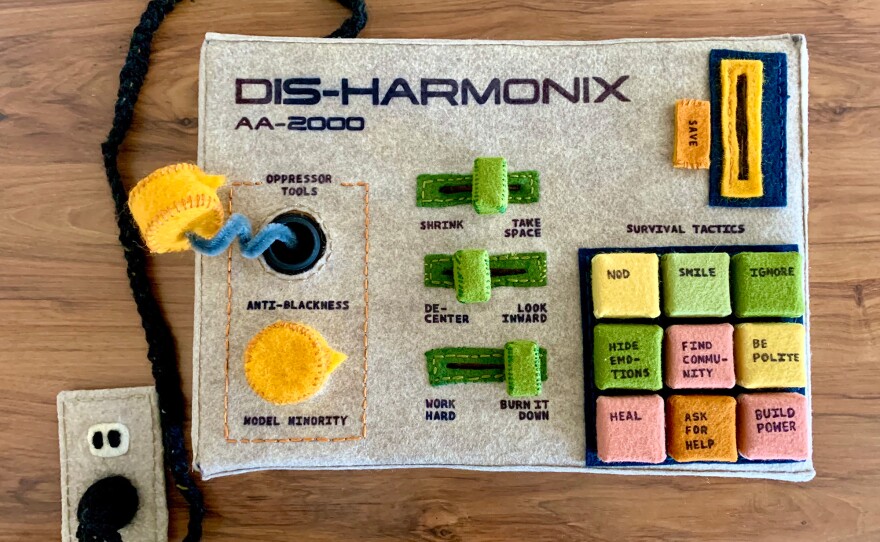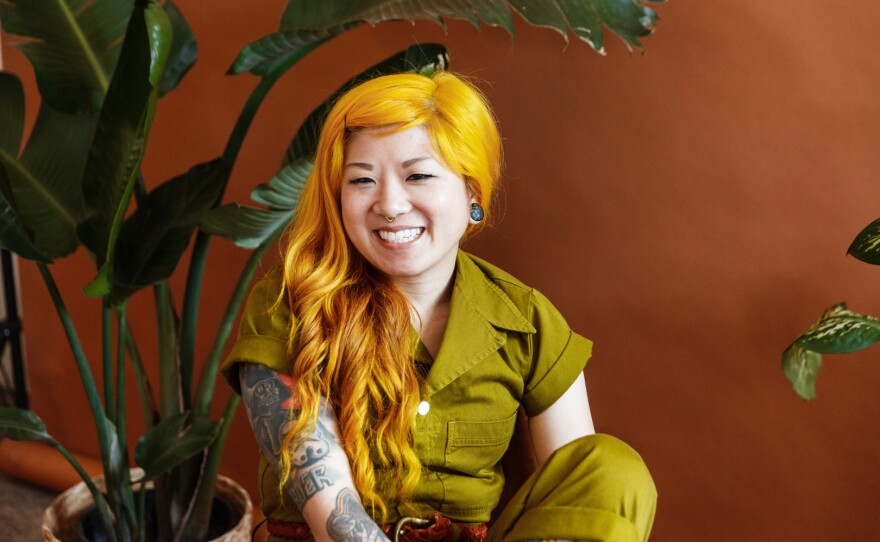"Wanting to pursue this show was out of necessity of what was happening in this moment in time," said Carmela Prudencio, curator of "Ghidorah Lives," a new group exhibition featuring art by Asian American Pacific Islander (AAPI) artists in San Diego.
Prudencio is the self-described "co-conspirator" of Teros Gallery with Alejandra Frank, and also serves as marketing director for Pacific Arts Movement. This exhibition is presented by Teros and Burn All Books at Good Faith Gallery.
This project is the first exhibition Teros has held since closing their physical space in December 2020.
RELATED: Closed Doors, 'New Suns' For Teros Gallery
Prudencio began this exhibition with a monster: King Ghidorah. Originally an enemy of Godzilla, Prudencio said that Ghidorah is traditionally a misunderstood antagonist, a three-headed dragon-like daikaiju, or giant beast, in the Japanese Godzilla canon.

"I've been thinking about archive and canon a lot. I can't figure out why Asian American activism feels like it's buried sometimes, and we speak of it as a thing of the past. But this is happening right now and I see it every single day in the spaces that I'm in. And a good example of documentation of the work that Asian American organizers were doing was 'Gidra,'" Prudencio said.
"Gidra," which was launched in 1969, is a radical, anti-imperialist Asian American zine, which underwent a revival in 2019. Concurrent with "Ghidorah Lives," Teros and Burn All Books are reproducing vintage "Gidra" issue covers, printed on the Burn All Books risograph, to sell as posters.
Fourteen artists are involved in the group show, pairing together sculpture, illustration, painting, projection, video, photography, zines and more.
Koy Suntichotinun, a Thai Teochew American artist, illustrated the poster for the exhibition, and also has a sculptural clock in the show. Suntichotinun took an actual clock — purchased on the cheap at Target — and deconstructed it.

He made an illustrated representation of himself to stand in as one of the clock's hands (the other is a green card) and rather than measuring time, it measures percentages and fractions of his identity.
"I've always had an issue with figuring out my identity. Am I Chinese? Am I Thai? Am I American? The only thing about me that's Chinese is my body, and culturally I'm Thai — I don't relate culturally in Chinese spaces — and I was raised in America even though I was born in Thailand. That created a weird issue where I would speak in fractions," said Suntichotinun.
The background of the clock is like a pie chart with foods from various regions that are part of his identity.
"It's kind of ridiculous to talk about folks in weird fraction forms. Regardless of how much blood I have in whatever, culturally, I'm one hundred percent of everything. I am one hundred percent Thai. I am one hundred percent Chinese. These little proportions don't really matter," Suntichotinun said.
Maya Grace Misra is an Indian-American artist living in San Diego. Misra's work is part of her "Home of a Martyr" project, where she recreated and reimagined the life of her aunt, Blossom Misra Khan, who was a political activist in India who was killed when Misra was young.
"I began rearranging my own apartment to better suit the life I imagined for her in the present day. So it's this project where I'm rearranging my own living space and creating the space that exists between us, essentially, and it's become really important to me as a way to get to know her, but also to build this life for her that she didn't get to have," said Misra.

After living with a particular vignette or scene for a while, Misra photographed it, then processed these photographs onto positive slides. The photographs will be projected in the gallery using a vintage slide projector.
One striking photograph is a setting of a nightstand arrayed with picture frames holding images of political activism. At first glance, it's a straightforward still life, but upon a closer look, a lit candle balances precariously on the edge of the nightstand, about to fall.
As deeply personal as this family history work is for Misra, it's also a bigger statement of activism.
"I've always been particularly interested in how can my artwork serve this greater purpose. Rather than just being about representing or making something pretty, how can it speak to these larger truths so that, potentially, there's the possibility for change and for radical growth. Activism, or at least community organizing, and art, for me are very, very closely intertwined," Misra said.
Designer and artist Stacey Uy created a felt, machine-like sculpture called "Dis-Harmonix AA-2000." It features buttons and dials with what Uy describes as "survival tactics" on them, like "nod," "smile," "ignore," or "ask for help." A switch suggests either shrink or take up space.

"I think the past year has really shown me all the ways in which certain modes of survival or ways of being in the world that I've been taught to use for my own protection have actually been weaponized against other folks," said Uy. "So it's really just a way to showcase all of that anxiety about what we've been taught to perform or taught to be."
Uy's work is highly personal, but is also steeped in history. She also writes a zine called "Radical History Club," and uses design and art to reclaim or redistribute power and stories.
"I realized that there is another way to show up as an Asian person, like this is what it looks like to be in solidarity with people and to look the way that I do," Uy said. "I'm really passionate about history, about learning about the ancestral knowledge that people have left us — not only just from your biological family, but also from movement organizers in the past."

For Uy, the exhibition is a way of broadening the narrative of the AAPI community right now.
"Ghidorah Lives is kind of giving us that opportunity to express our identities in a way that can't be co-opted by corporations and this whole hashtag, like Stop AAPI Hate. It's so much more than that," Uy said.
Other artists include Tarrah Aroonsakool, Julie Choo, Goldie Lamoar, Hatepaste, Heval, Shanika Lazo, Ellis Luu, Johnny Nguyen, Hiyas Saturay, Eric Tandog and Wednesday Tran.

Exhibition details:
"Ghidorah Lives" is on view May 28 - June 19 at Good Faith Gallery, 566 19th St., Sherman Heights.
Opening weekend drop in hours:
- Friday and Saturday, May 28-29 from 6-10 p.m.
- Sunday May 30 from 12-5 p.m.
- By appointment thereafter.
By connecting this exhibition to Ghidorah the monster, curator Carmela Prudencio wants to call attention to misunderstandings.
"Very often Asian Americans are used as racial wedges, and are used to divide communities," Prudencio said, pointing to the role of the media and propaganda. "Why a lot of these attacks were happening was the person that was in the White House last year was calling the coronavirus 'kung flu,' 'the Chinese virus.' So the things that happened this spring are not a surprise to me."
Prudencio said this show is a love letter to organizers and activists in the local AAPI community and beyond: "I want us to reclaim our power and be able to speak for ourselves. And also for this show, let the artists' work speak to it."






